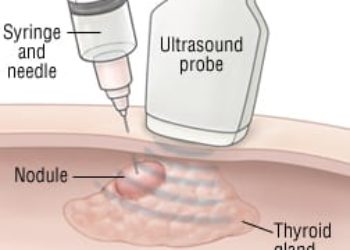Three ultrasonographic findings portend increased risk of malignancy in thyroid nodules
Image: PD
1. Three ultrasound characteristics of thyroid nodules were indicative of increased risk of cancer including: microcalcifications, size greater than 2 cm and entirely solid composition.
2. Limiting biopsy to patients with only microcalcifications or greater than two high-risk ultrasound features would eliminate up to 90% of all biopsies with a cancer risk of only 0.5% in unbiopsied nodules.
Evidence Rating Level: 3 (Average)
Study Rundown: There is a high incidence of thyroid nodules in the general population, but only a small percentage of these are malignant. Furthermore, many thyroid neoplasms may never become clinically significant. This study identifies 3 high risk ultrasonographic features of malignant thyroid nodules by comparing thyroid ultrasounds of known malignant nodules with those of non-cancerous nodules. By using the California Cancer Registry to identify cases of thyroid cancer within the study population of all people who underwent thyroid ultrasound at UCSF during the study period, this study avoided the ascertainment bias of prior studies, which looked only at nodules which underwent biopsy.
The study found that only 3 ultrasonographic findings conveyed an increased risk of malignancy including: microcalcifications, size >2cm and entirely solid composition. Other characteristics did not signify an increased risk of cancer. Based on their model, they suggest that reasonable criteria for biopsy would be the presence of microcalcifications or 2 or more of the criteria, which would yield a false negative rate of only 0.5% and would substantially reduce the number of biopsies performed. This study is limited by the fact that it is based on data from only one institution, and there was a minimum of only 2 years of follow-up, so clinically significant cancers could have developed after the study period, and would not be captured by this analysis.
Click to read the study in JAMA Internal Medicine
In-Depth [retrospective case-control study]: This study included a total of 11,618 examinations performed on 8,806 patients, of whom 105 were subsequently diagnosed with cancer of the thyroid. It was found that the presence of microcalcifications in a thyroid nodule conveyed the highest risk of malignancy and were present in 38.2 % of cancerous nodules as compared to 5.4% of benign nodules (OR, 8.1; 95% CI, 3.8-17.3; P<.001). Size >2cm was also associated with an increased risk of malignancy (OR, 3.6; 95% CI, 1.7-7.6; P=.001), as was an entirely solid composition (OR, 4.0; 95% CI, 1.7-9.2; P=.001). They found that the presence of any one of these characteristics was 88% sensitive for malignancy, but was non-specific and carried a risk of cancer of only 1.8% (95% CI, 0.015-0.022). The presence of microcalcifications alone conveyed an 8.2% (95% CI, 0.059-0.110) increased risk of cancer, while the presence of any 2 features had a 6.2% (95% CI, 0.047-0.080) increased risk. The number needed to biopsy in order to diagnose cancer was 12 (95% CI, 9-17) for microcalcifications, 16 (95% CI, 13-21) for any 2 features, as compared to 56 (95% CI, 45-67) for any single feature alone.
By Evan Shalen and Brittany Hasty
More from this author: Healthy diet delays development, progression of chronic kidney disease in diabetics
© 2013 2minutemedicine.com. All rights reserved. No works may be reproduced without expressed written consent from 2minutemedicine.com. Disclaimer: We present factual information directly from peer reviewed medical journals. No post should be construed as medical advice and is not intended as such by the authors, editors, staff or by 2minutemedicine.com. PLEASE SEE A HEALTHCARE PROVIDER IN YOUR AREA IF YOU SEEK MEDICAL ADVICE OF ANY SORT.




